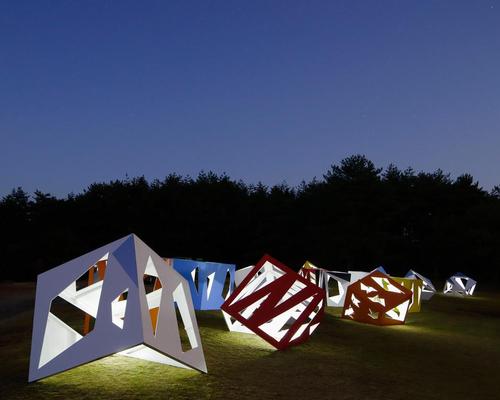21 May 2018
Moriyuki Ochiai seeks to surprise and delight with 'Constellation of Stargazing Tea Rooms'
BY Kim Megson

Japanese studio Moriyuki Ochiai Architects have designed a cluster of vibrant, polygonal tea houses that double as a new “sanctuary for stargazing” for budding astronomers.
Surrounded by rolling hills in the town of Bisei, Okayama Prefecture, the ‘Constellation of Stargazing Tea Rooms’ has been conceived for visitors who wish to participate in traditional tea ceremonies, watch concerts and plays, and, at night, sit back and look up at the stars.
Painted in bright colours, each separate volume has unusually-shaped openings, through which people inside can observe the sky and surrounding nature. Mirrors placed on the exterior walls reflect the outdoor environment, subtly modifying their appearance throughout the day.
Bisei is a famed stargazing hotspot (its name translates to ‘beautiful sky’ in English) and it was also the birthplace of Eisei, a Japanese Buddhist priest credited with introducing green tea to Japan – explaining the unusual hybrid of typologies.
“The constellation of tea rooms is in harmony with the surrounding undulating terrain, thus creating a landscape in which the indoor and outdoor expand seamlessly like the flow of a river under the Milky Way,” said studio founder Moriyuki Ochiai.
“The Japanese tea room was originally developed as an enclosed microcosm called an ‘enclosure,’ and as such, each of our units is designed as a separate spatial installation. From within, one can perceive minute changes in the natural surroundings and experience the wonder and mystery of natural phenomena.
“The loose gathering of tea rooms creates an environment enhancing the fun and joy derived from human activities.”
In recent times, architects and developers have been designing increasingly quirky places from which to enjoy the night sky.
Remote holiday specialists Off the Map Travel have created a semi-transparent glamping cabin in Finland that can be towed into the remote wilderness of the Arctic Circle for guests to experience the Northern Lights from the comfort of their beds; WG+P Architects have designed three ‘Sky Huts’ in Wales with retractable roofs so that campers “can observe the heavens”; and Snøhetta have been commissioned to transform Norway’s largest astronomical facility into a visitor attraction, with amenities housed in a series of scattered cabins shaped like small planets.
Close Window